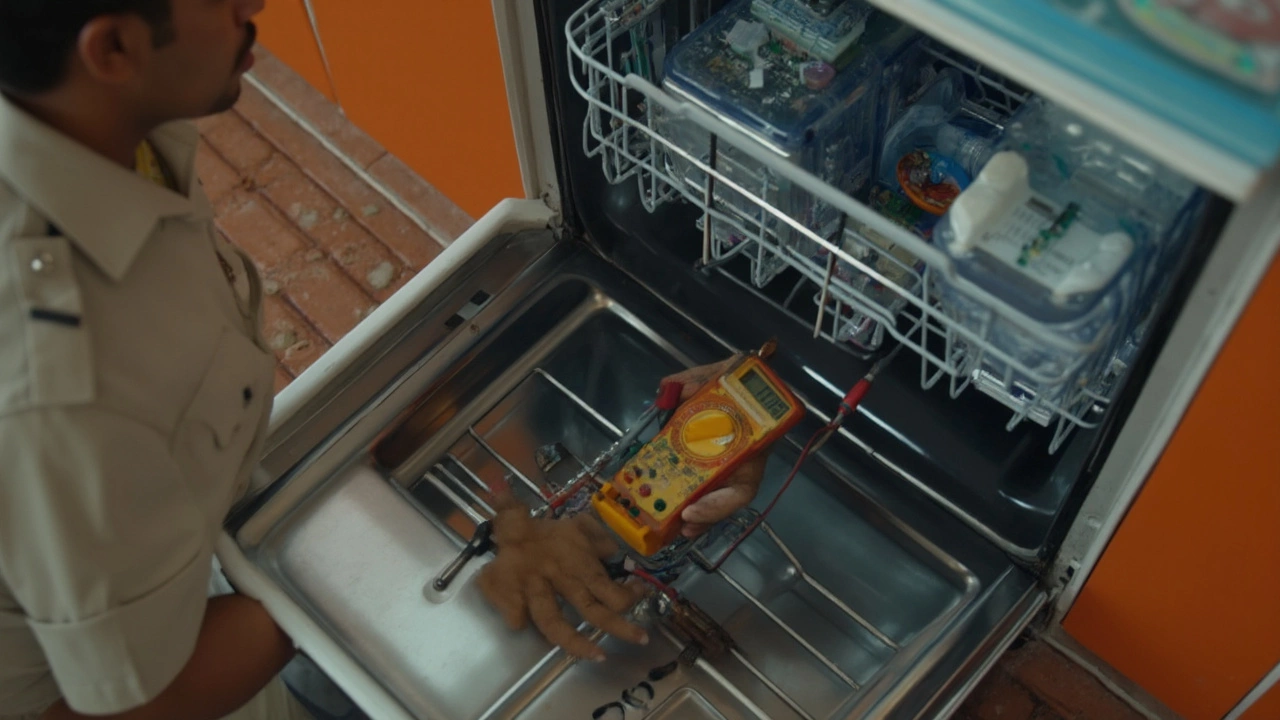Nothing ruins the after-dinner vibe like opening your dishwasher and finding dirty plates still staring back at you. Before you panic or start shopping for a new machine, you should know that most dishwasher problems can actually be fixed, and sometimes the solution is way simpler than you'd expect.
Take a jammed spray arm or a clogged filter—these are classic culprits behind poor cleaning performance, and both are things you can easily reach and clean yourself. Even things like a leaky door or a dishwasher that won’t start are often caused by a loose seal or a tripped circuit breaker, not a major mechanical meltdown.
Repair shops see the same handful of issues over and over. So if your dishwasher isn’t draining or the controls aren’t responding, it’s usually fixable. The real headache comes when the problem involves the control board or the pump motor—those repairs can sometimes cost more than the machine’s worth, especially in older models.
- Common Dishwasher Problems That Are Repairable
- When Repair Makes Sense Versus Replacement
- Simple Fixes You Can Try Yourself
- Knowing When to Call a Professional
Common Dishwasher Problems That Are Repairable
Most dishwasher repair calls come down to a handful of issues, and the good news is, a lot of them don’t require fancy tools or hours of work. If your dishwasher isn’t cleaning, leaking, or just acting weird, there’s a good chance you can fix it or at least know if a pro can.
- Clogged Filters: One of the most common causes for poor cleaning is a dirty filter trapped with food bits. Just pull it out, rinse it, and you’re good to go.
- Blocked Spray Arms: Sometimes the spinning arms that shoot water get blocked by seeds, pasta, or even glass shards. Pop them off, poke out the holes, and snap them back in place.
- Door Seal Leaks: If water’s puddling out the front, check the rubber gasket around the door. Wipe it down or replace it, which you can do in minutes without calling anyone.
- Drainage Issues: If the bottom’s full of water after a cycle, there could be a blockage in the drain hose or air gap. Remove any visible gunk and run a short cycle to test it.
- Tripped Circuit or Dead Control Panel: Dishwashers that don’t start are often traced back to a tripped breaker or a stuck-on child lock. Check your home’s breaker box first, then try a reset by turning off power to the machine for a few minutes.
Did you know? According to a recent repair industry survey, about 70% of broken dishwashers brought in for service could be fixed without major part replacement. Usually, the problem was a filter, spray arm, or wiring glitch.
| Problem | Difficulty | DIY Friendly? |
|---|---|---|
| Clogged Filter | Easy | Yes |
| Spray Arm Blockage | Easy | Yes |
| Seal Leak | Easy | Yes |
| Drainage Issue | Moderate | Usually |
| Control Panel Reset | Easy | Yes |
Most of these repairs will run you less than the price of a pizza if you do it yourself. So before thinking about tossing your old dishwasher, check these common issues—they’re usually fixable in under an hour.
When Repair Makes Sense Versus Replacement
Trying to decide if you should fix your dishwasher or just get a new one? You’re not the only one scratching your head. Here’s the deal—you want to look at the age of your machine, the cost of the dishwasher repair, and what the problem actually is.
If your dishwasher is under seven years old, repair usually makes more sense, especially if it’s been working well otherwise. Most major brands—like Whirlpool or Bosch—are built to last at least a decade if you take care of them. Spending a little to replace a faulty pump or busted latch beats shelling out for a whole new machine.
But age isn’t the only factor. Cost matters a ton. If the repair bill is less than 50% of a new dishwasher, fixing it is a no-brainer. But if the repair costs keep stacking up—think two or three big fixes in the last year—you’re throwing money down the drain. That’s especially true if your machine is older and parts are getting harder to find.
- Newer models with basic issues: Fix them. It’s usually something simple and cheap.
- Expensive problems like a failed motor or control board: Check costs. If it’s getting close to half the price of a new machine, replacement is smarter.
- Mysterious leaks and rusted tubs: These are often costly and can mean it’s time to move on.
To put things in perspective, the cost of a standard appliance troubleshooting service visit ranges from $75 to $150, and common repairs like replacing inlet valves or door seals usually stay under $200. Meanwhile, a brand new mid-range dishwasher averages $600 to $900.
| Repair Type | Average Cost |
|---|---|
| Spray Arm Replacement | $50 - $100 |
| Door Seal | $60 - $120 |
| Pump Motor | $300 - $400 |
| Control Board | $200 - $350 |
If you’re seeing repairs creep into the $350+ range and your dishwasher is more than ten years old, upgrade. You’ll probably save in electricity and water too—modern dishwashers use about half the energy and gallons per cycle compared to machines made before 2013.

Simple Fixes You Can Try Yourself
If your dishwasher repair feels intimidating, know this: you don’t need to be a pro to handle the most common issues. Most people can fix at least half of everyday dishwasher problems with tools they already own (think: a screwdriver and a flashlight).
First up, let’s talk about filters. A clogged filter is the number one reason dishwashers leave gunk on dishes. Pull out the bottom rack and twist or lift out the filter—it’s usually front and center under the spray arm. Give it a good rinse under tap water. If it’s greasy, use a soft brush to clear out stuck food.
Struggling with unwashed dishes or water spraying weakly? The spray arms might need attention. Take them out (usually they just snap or twist off) and poke out food bits with a toothpick. Rinse away any sludge. Make sure nothing’s blocking them from spinning freely when you reinstall.
Door leaks aren’t as dramatic as they look. Open the door and check the rubber door seal, also called a gasket. If you see crumbs, wipe them away. If the seal is loose, try pressing it back into its groove. Sometimes, a leaky door just needs a tightener on the door latch, which often means turning a screw a quarter turn.
If the appliance troubleshooting leads you to a dishwasher that’s dead (no lights, no sound), check two things: the circuit breaker in your fuse box and the outlet where it’s plugged in. Many dishwashers share power with your garbage disposal; if the disposal’s not working either, it’s almost always a tripped breaker or GFCI outlet.
When drainage is the problem—water pooled in the bottom—start by popping open the bottom kickplate (that’s the panel at floor level) and inspecting the drain hose. Kinks and clogs are common, especially if the hose makes a sharp turn under the sink. Unplug the machine, disconnect the hose, flush it out, and you’ll likely solve the drainage problem.
Not sure how often to clean your dishwasher’s guts? Here are some handy numbers:
| Dishwasher Task | How Often |
|---|---|
| Clean filter | Once a month |
| Check spray arms | Every 2 months |
| Wipe door seal | Every 3 months |
Stick to these basics, and you’ll avoid a lot of hassle—and might even skip calling for home DIY help or a repair tech for years.
Knowing When to Call a Professional
Even if you’re pretty handy, there’s a point when fixing a dishwasher repair problem yourself starts to get risky—or just plain frustrating. Some fixes are just not safe, especially if they involve the electrical wiring or water connections inside your machine. When you spot sparks, burning smells, or any sign of a serious leak, it’s time to step back and call someone who knows their stuff.
Warranty is a big one. If your dishwasher is under warranty, opening it up can actually void that coverage. Most manufacturers want a certified tech to work on covered repairs, so it’s smarter to check your paperwork before breaking out the toolbox.
You’ll also want to call in the pros for things like:
- Replacing the control board or pump motor (these parts are expensive and need special know-how).
- Issues with the door that aren’t solved by replacing the seal (like a misaligned or broken latch mechanism).
- Unexplained error codes, flashing lights, or a dishwasher that won’t respond even after resetting the power.
- Strange grinding or banging noises; these can mean a failing motor or broken internal part.
If you’re still not sure, here’s a quick table showing the average repair costs compared to what a new dishwasher might run you:
| Repair Type | Average Cost (USD) | Worth Repairing? |
|---|---|---|
| Clogged drain or pump | $100 – $200 | Yes |
| Door latch replacement | $125 – $250 | Usually |
| Control board replacement | $300 – $400 | Maybe (depends on age) |
| Major leaks | $150 – $350 | Depends |
| New dishwasher | $500 – $1,200+ | — |
If the repair cost is half—or more—of what a new dishwasher would cost, it usually makes more sense to replace the whole thing, especially if yours is over 8 years old. When in doubt, a quick call to a dishwasher repair expert can save you time and money in the long run.



